Efficient Energy Saving Scenarios for Indoor PM2.5 Management in an Apartment of South Korea
Abstract
:1. Introduction
2. Materials and Methods
2.1. Experimental Design
2.2. Theoretical Model of Indoor PM2.5 and Energy Consumption
3. Results and Discussion
4. Conclusions
Author Contributions
Funding
Institutional Review Board Statement
Informed Consent Statement
Data Availability Statement
Conflicts of Interest
References
- Klepeis, N.E.; Nelson, W.C.; Ott, W.R.; Robinson, J.P.; Tsang, A.M.; Switzer, P.; Behar, J.V.; Hern, S.C.; Engelmann, W.H. The National Human Activity Pattern Survey (NHAPS): A resource for assessing exposure to environmental pollutants. J. Expo. Sci. Environ. Epidemiol. 2001, 11, 231–252. [Google Scholar] [CrossRef] [PubMed] [Green Version]
- Loomis, D.; Grosse, Y.; Lauby-Secretan, B.; El Ghissassi, F.; Bouvard, V.; Benbrahim-Tallaa, L.; Guha, N.; Baan, R.; Mattock, H.; Straif, K. The carcinogenicity of outdoor air pollution. Lancet Oncol. 2013, 14, 1262. [Google Scholar] [CrossRef]
- International Agency for Research on Cancer (IARC). Outdoor Air Pollution; IARC Monographs on the Evaluation of Carcinogenic Risks to Humans; IARC: Lyon, France, 2016; Volume 109, p. 9.
- Martins, N.R.; Carrilho da Graça, G. Impact of outdoor PM2.5 on natural ventilation usability in California’s nondomestic buildings. Appl. Energy 2017, 189, 711–724. [Google Scholar] [CrossRef]
- Burnett, R.T.; Pope, C.A., III; Ezzati, M.; Olives, C.; Lim, S.S.; Mehta, S.; Shin, H.H.; Singh, G.; Hubbell, B.; Brauer, M.; et al. An integrated risk function for estimating the global burden of disease attributable to ambient fine particulate matter exposure. Environ. Health Perspect. 2014, 122, 397–403. [Google Scholar] [CrossRef]
- Evans, J.; van Donkelaar, A.; Martin, R.V.; Burnett, R.; Rainham, D.G.; Birkett, N.J.; Krewski, D. Estimates of global mortality attributable to particulate air pollution using satellite imagery. Environ. Res. 2013, 120, 33–42. [Google Scholar] [CrossRef]
- Lim, S.S.; Vos, T.; Flaxman, A.D.; Danaei, G.; Shibuya, K.; Adair-Rohani, H.; AlMazroa, M.A.; Amann, M.; Anderson, H.R.; Andrews, K.G.; et al. A comparative risk assessment of burden of disease and injury attributable to 67 risk factors and risk factor clusters in 21 regions, 1990–2010: A systematic analysis for the Global Burden of Disease Study 2010. Lancet 2012, 380, 2224–2260. [Google Scholar] [CrossRef] [Green Version]
- Lelieveld, J.; Helleis, F.; Borrmann, S.; Cheng, Y.; Drewnick, F.; Haug, G.; Klimach, T.; Sciare, J.; Su, H.; Pöschl, U. Model Calculations of Aerosol Transmission and Infection Risk of COVID-19 in Indoor Environments. Int. J. Environ. Res. Public Health 2020, 17, 8114. [Google Scholar] [CrossRef] [PubMed]
- Kohanski, M.A.; Lo, L.J.; Waring, M.S. Review of indoor aerosol generation, transport, and control in the context of COVID-19. Int. Forum Allergy Rhinol. 2020, 10, 1173–1179. [Google Scholar] [CrossRef]
- Pavlovas, V. Demand controlled ventilation: A case study for existing Swedish multifamily buildings. Energy Build. 2004, 36, 1029–1034. [Google Scholar] [CrossRef]
- Zhang, T.; Su, Z.; Wang, J.; Wang, S. Ventilation, indoor particle filtration, and energy consumption of an apartment in northern China. Build. Environ. 2018, 143, 280–292. [Google Scholar] [CrossRef]
- Ben-David, T.; Waring, M.S. Interplay of ventilation and filtration: Differential analysis of cost function combining energy use and indoor exposure to PM 2.5 and ozone. Build. Environ. 2018, 128, 320–335. [Google Scholar] [CrossRef]
- Zhao, L.; Liu, J.; Ren, J. Impact of various ventilation modes on IAQ and energy consumption in Chinese dwellings: First long-term monitoring study in Tianjin, China. Build. Environ. 2018, 143, 99–106. [Google Scholar] [CrossRef]
- Chen, J.; Brager, G.S.; Augenbroe, G.; Song, X. Impact of outdoor air quality on the natural ventilation usage of commercial buildings in the US. Appl. Energy 2019, 235, 673–684. [Google Scholar] [CrossRef]
- Liu, C.; Yang, J.; Ji, S.; Lu, Y.; Wu, P.; Chen, C. Influence of natural ventilation rate on indoor PM2. 5 deposition. Build. Environ. 2018, 144, 357–364. [Google Scholar] [CrossRef]
- Kang, K.; Kim, H.; Kim, D.D.; Lee, Y.G.; Kim, T. Characteristics of cooking-generated PM10 and PM2. 5 in residential buildings with different cooking and ventilation types. Sci. Total Environ. 2019, 668, 56–66. [Google Scholar] [CrossRef] [PubMed]
- O’Leary, C.; de Kluizenaar, Y.; Jacobs, P.; Borsboom, W.; Hall, I.; Jones, B. Investigating measurements of fine particle (PM 2.5) emissions from the cooking of meals and mitigating exposure using a cooker hood. Indoor Air 2019, 29, 423–438. [Google Scholar] [CrossRef]
- Kim, M.; Jung, H.; Park, E.; Jurng, J. Performance of an air purifier using a MnOx/TiO2 catalyst-coated filter for the decomposition of aldehydes, VOCs and ozone: An experimental study in an actual smoking room. Build. Environ. 2020, 186, 107247. [Google Scholar] [CrossRef]
- Kim, H.-J.; Han, B.; Woo, C.G.; Kim, Y.-J.; Lim, G.-T.; Shin, W.G. Air cleaning performance of a novel electrostatic air purifier using an activated carbon fiber filter for passenger cars. IEEE Trans. Ind. Appl. 2017, 53, 5867–5874. [Google Scholar] [CrossRef]
- Kim, M.; Lim, G.-T.; Kim, Y.-J.; Han, B.; Woo, C.G.; Kim, H.-J. A novel electrostatic precipitator-type small air purifier with a carbon fiber ionizer and an activated carbon fiber filter. J. Aerosol Sci. 2018, 117, 63–73. [Google Scholar] [CrossRef]
- Sharma, R.; Balasubramanian, R. Evaluation of the effectiveness of a portable air cleaner in mitigating indoor human exposure to cooking-derived airborne particles. Environ. Res. 2020, 183, 109192. [Google Scholar] [CrossRef]
- Barn, P.; Gombojav, E.; Ochir, C.; Laagan, B.; Beejin, B.; Naidan, G.; Boldbaatar, B.; Galsuren, J.; Byambaa, T.; Janes, C.; et al. The effect of portable HEPA filter air cleaners on indoor PM2. 5 concentrations and second hand tobacco smoke exposure among pregnant women in Ulaanbaatar, Mongolia: The UGAAR randomized controlled trial. Sci. Total Environ. 2018, 615, 1379–1389. [Google Scholar] [CrossRef] [PubMed]
- Brehmer, C.; Norris, C.; Barkjohn, K.K.; Bergin, M.H.; Zhang, J.; Cui, X.; Zhang, Y.; Black, M.; Li, Z.; Shafer, M.; et al. The impact of household air cleaners on the chemical composition and children’s exposure to PM2. 5 metal sources in suburban Shanghai. Environ. Pollut. 2019, 253, 190–198. [Google Scholar] [CrossRef] [PubMed]
- Noh, K.-C.; Yook, S.-J. Evaluation of clean air delivery rates and operating cost effectiveness for room air cleaner and ventilation system in a small lecture room. Energy Build. 2016, 119, 111–118. [Google Scholar] [CrossRef]
- Shrouf, F.; Ordieres, J.; Miragliotta, G. Smart factories in Industry 4.0: A review of the concept and of energy management approached in production based on the Internet of Things paradigm. In Proceedings of the 2014 IEEE International Conference on Industrial Engineering and Engineering Management, Selangor, Malaysia, 9–12 December 2014; pp. 697–701. [Google Scholar]
- Chung, W.; Hui, Y.V. A study of energy efficiency of private office buildings in Hong Kong. Energy Build. 2009, 41, 696–701. [Google Scholar] [CrossRef]
- Wang, L.; Greenberg, S.; Fiegel, J.; Rubalcava, A.; Earni, S.; Pang, X.; Yin, R.; Woodworth, S.; Hernandez-Maldonado, J. Monitoring-based HVAC commissioning of an existing office building for energy efficiency. Appl. Energy 2013, 102, 1382–1390. [Google Scholar] [CrossRef]
- World Health Organization. Air Quality Guidelines: Global Update 2005: Particulate Matter, Ozone, Nitrogen Dioxide, and Sulfur Dioxide; World Health Organization: Geneva, Switzerland, 2006.
- World Health Organization Regional Office for Europe. Review of Evidence on Health Aspects of Air Pollution–REVIHAAP Project; WHO: Geneva, Switzerland, 2013.
- Brelih, N.; Seppänen, O. Ventilation rates and IAQ in European standards and national regulations. In Proceedings of the 32nd AIVC Conference and 1st TightVent Conference, Brussels, Belgium, 12–13 October 2011; pp. 12–13. [Google Scholar]
- Noh, K.-C.; Oh, M.-D. Variation of clean air delivery rate and effective air cleaning ratio of room air cleaning devices. Build. Environ. 2015, 84, 44–49. [Google Scholar] [CrossRef]
- Patel, T.; Mitsingas, C.; Miller, J.P.; Newell, T.A. Comparison of blower door and tracer gas testing methods for determination of air infiltration rates through building envelopes at normal operating conditions. In Proceedings of the ASME 2011 5th International Conference on Energy Sustainability, Washington, DC, USA, 7–10 August 2011; pp. 1013–1019. [Google Scholar]
- Meier, A. Infiltration: Just ACH50 divided by 20? Home Energy 1994, 11, 25–37. [Google Scholar]
- Lai, A. Particle deposition indoors: A review. Indoor Air 2002, 12, 211–214. [Google Scholar] [CrossRef]
- KMA. Annual Climatological Report; Korea Meteorological Administration: Seoul, Korea, 2019.
- Bae, C.; Chun, C. Research on seasonal indoor thermal environment and residents’ control behavior of cooling and heating systems in Korea. Build. Environ. 2009, 44, 2300–2307. [Google Scholar] [CrossRef]
- Deng, G.; Li, Z.; Wang, Z.; Gao, J.; Xu, Z.; Li, J.; Wang, Z. Indoor/outdoor relationship of PM2. 5 concentration in typical buildings with and without air cleaning in Beijing. Indoor Built Environ. 2017, 26, 60–68. [Google Scholar] [CrossRef]
- Clements, N.; Keady, P.; Emerson, J.B.; Fierer, N.; Miller, S.L. Seasonal variability of airborne particulate matter and bacterial concentrations in Colorado homes. Atmosphere 2018, 9, 133. [Google Scholar] [CrossRef]
- ANSI/AHAM AC-1-2015; Method for Measuring Performance of Portable Household Electric Room Air Cleaners. AHAM: Washington, DC, USA, 2015.
- EPA. Guide to Air Cleaners in the Home; U.S. EPA/Office of Radiation and Indoor Air Indoor Environments Division: Washington, DC, USA, 2018.
- Harriman, L.; Stephens, B.; Brennan, T. New Guidance for Residential Air Cleaners. ASHRAE J. 2019, 61, 14–23. [Google Scholar]

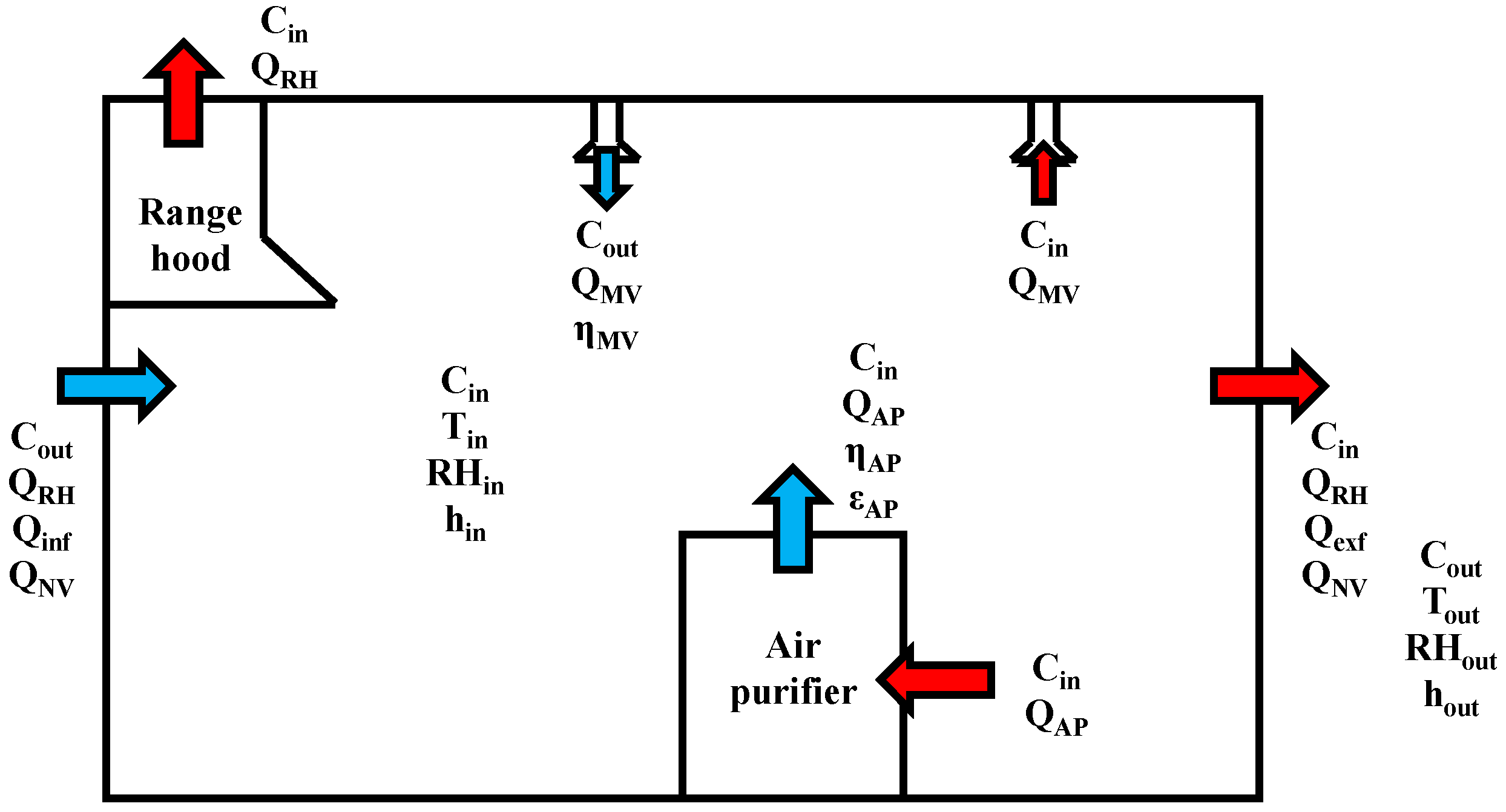

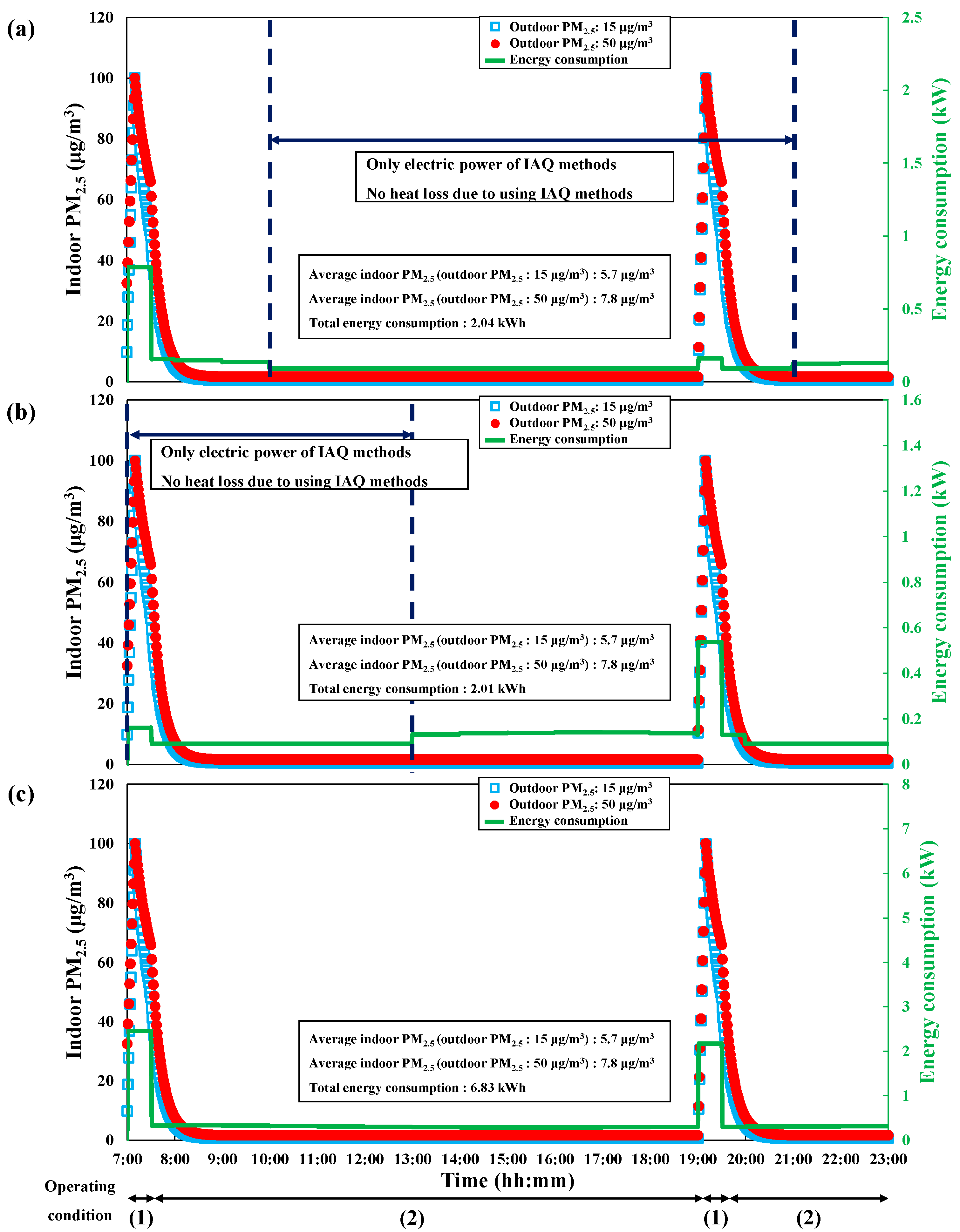

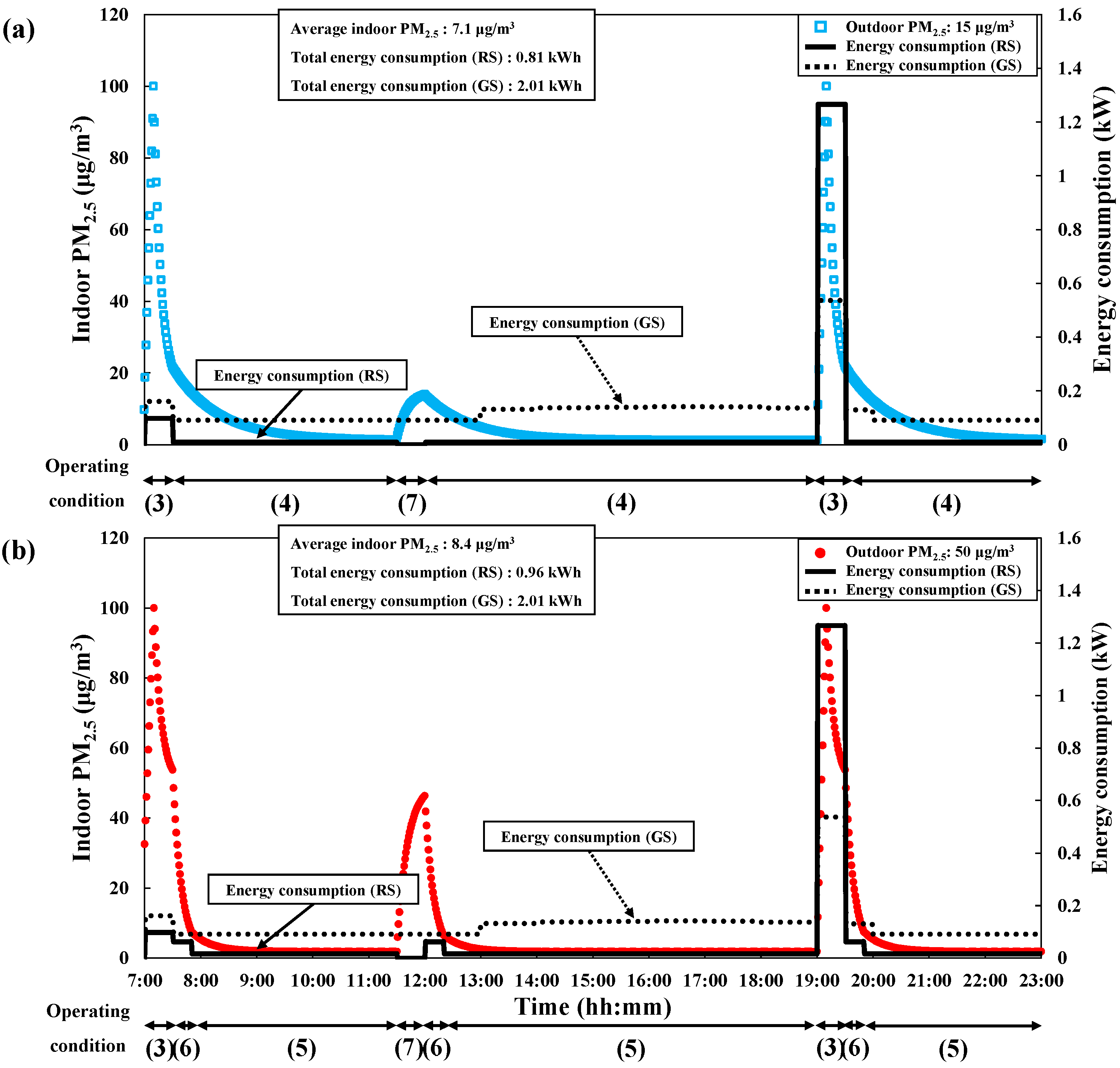

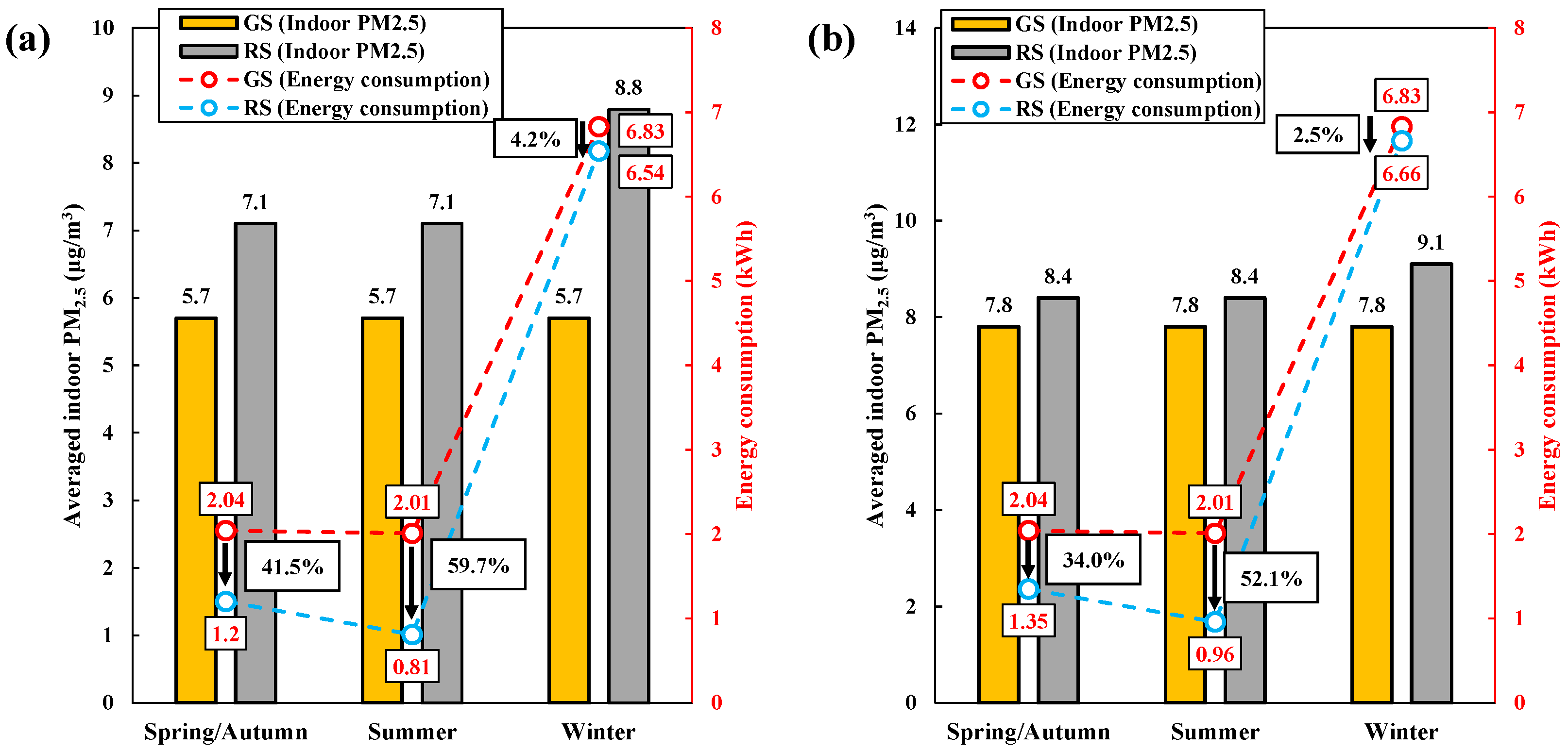
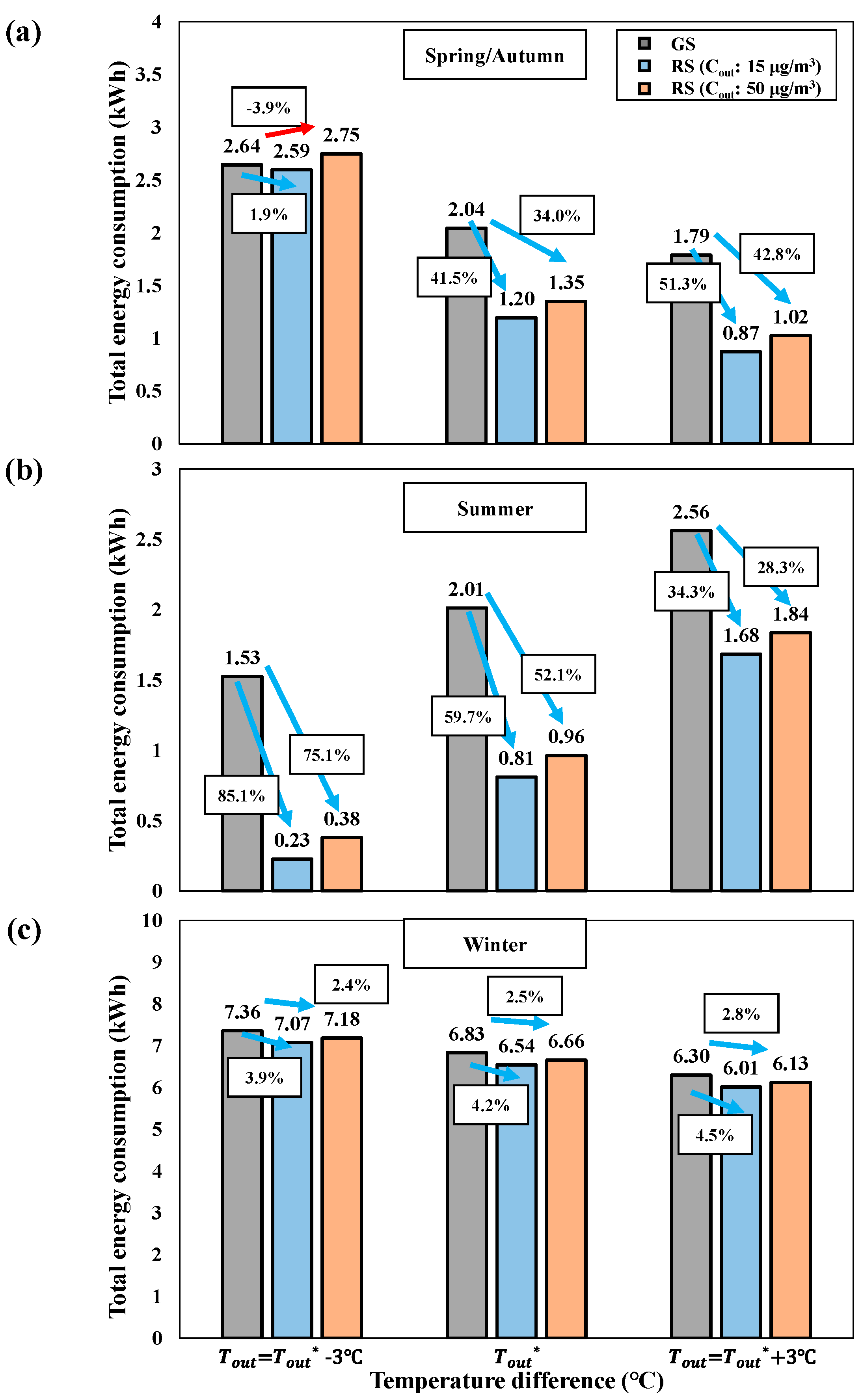
| IAQ Management Method | Mechanical Ventilation | Natural Ventilation | Air Purifier | Range Hood |
|---|---|---|---|---|
| Flow rate (m3/min) | 0.7 | Wind speed × Kitchen window area ) | 2.0 (mode 1) 5.0 (mode 2) 7.5 (mode 3) 11.0 (mode 4) ) | 3.1 ) |
| PM2.5 removal efficiency (%) | 70 ) | - | 99.9 ) | - |
| Short circuiting factor (-) | - | - | 0.75 ) | - |
| Volume of apartment (, m3): 84.6 Deposition rate of apartment (, min−1): 0.0008 , m3/min): 0.16 (μg/m3) (μg/m3) (min) | ||||
| Time (hh:mm) | Spring/Autumn | Summer | Winter | |||||||||
|---|---|---|---|---|---|---|---|---|---|---|---|---|
| Outdoor | Indoor | Outdoor | Indoor | Outdoor | Indoor | |||||||
| RH (%) | RH (%) | RH (%) | RH (%) | RH (%) | RH (%) | |||||||
| 07:00 | 13.7 | 70.0 | 24.6 | 31.5 | 22.3 | 76.5 | 26.6 | 51.1 | −2.5 | 60.0 | 23.9 | 25.0 |
| 08:00 | 14.9 | 64.7 | 24.7 | 31.3 | 23.3 | 72.0 | 26.7 | 50.9 | −2.6 | 59.8 | 23.9 | 25.0 |
| 09:00 | 16.6 | 58.2 | 24.8 | 31.2 | 24.4 | 67.6 | 26.8 | 50.7 | −1.9 | 55.0 | 23.9 | 24.9 |
| 10:00 | 18.4 | 52.9 | 24.8 | 31.0 | 25.6 | 62.6 | 26.8 | 50.5 | −0.3 | 49.8 | 24.0 | 24.8 |
| 11:00 | 19.8 | 48.4 | 24.9 | 30.9 | 26.6 | 59.0 | 26.9 | 50.3 | 1.2 | 45.2 | 24.1 | 24.6 |
| 12:00 | 20.9 | 45.3 | 25.0 | 30.8 | 27.4 | 56.6 | 26.9 | 50.2 | 2.5 | 41.5 | 24.2 | 24.5 |
| 13:00 | 21.7 | 42.8 | 25.0 | 30.7 | 28.1 | 54.1 | 27.0 | 50.0 | 3.4 | 39.4 | 24.3 | 24.4 |
| 14:00 | 22.1 | 41.8 | 25.0 | 30.7 | 28.7 | 52.5 | 27.0 | 49.9 | 4.1 | 37.9 | 24.3 | 24.4 |
| 15:00 | 22.3 | 42.1 | 25.0 | 30.7 | 29.1 | 51.2 | 27.0 | 49.9 | 4.5 | 37.4 | 24.4 | 24.4 |
| 16:00 | 22.1 | 42.7 | 25.0 | 30.7 | 29.0 | 52.3 | 27.0 | 50.0 | 4.3 | 37.6 | 24.4 | 24.4 |
| 17:00 | 21.4 | 46.2 | 25.0 | 30.9 | 28.6 | 54.3 | 27.0 | 50.1 | 3.6 | 40.1 | 24.3 | 24.5 |
| 18:00 | 20.3 | 49.8 | 24.9 | 31.0 | 27.8 | 56.8 | 27.0 | 50.3 | 2.4 | 44.0 | 24.2 | 24.6 |
| 19:00 | 19.0 | 53.4 | 24.9 | 31.1 | 26.8 | 60.5 | 26.9 | 50.5 | 1.7 | 47.3 | 24.2 | 24.7 |
| 20:00 | 18.1 | 56.5 | 24.8 | 31.2 | 25.7 | 64.6 | 26.8 | 50.7 | 1.0 | 49.9 | 24.1 | 24.7 |
| 21:00 | 17.4 | 58.6 | 24.8 | 31.2 | 25.0 | 67.3 | 26.8 | 50.8 | 0.6 | 51.7 | 24.1 | 24.8 |
| 22:00 | 16.8 | 60.5 | 24.8 | 31.3 | 24.4 | 69.5 | 26.8 | 50.9 | 0.2 | 53.2 | 24.1 | 24.8 |
| 23:00 | 16.2 | 62.4 | 24.7 | 31.3 | 23.9 | 71.0 | 26.7 | 51.0 | −0.2 | 54.2 | 24.0 | 24.9 |
| Operating condition 1 | MV + RH |
| Operating condition 2 | MV + AP mode 3 |
| Operating condition 3 | NV + RH |
| Operating condition 4 | AP mode 1 |
| Operating condition 5 | AP mode 2 |
| Operating condition 6 | AP mode 4 |
| Operating condition 7 | NV |
| Operating condition 8 | MV + AP mode 1 |
| Operating condition 9 | MV + AP mode 2 |
| Time (hh:mm) | Operating Condition for Spring/Autumn, Summer, and Winter | Remark |
|---|---|---|
| 07:00–07:30 | 1 | Cooking (07:00–07:10) |
| 07:30–19:00 | 2 | - |
| 19:00–19:30 | 1 | Cooking (07:00–07:10) |
| 19:30–23:00 | 2 | - |
| Time (hh:mm) | Operating Conditions for Spring/Autumn, and Summer | Remark | |
|---|---|---|---|
| Outdoor PM2.5: 15 μg/m3 | Outdoor PM2.5: 50 μg/m3 | ||
| 07:00–07:30 | 3 (NV + RH) | 3 (NV + RH) | Cooking (07:00–07:10) |
| 07:30–08:00 | 4 (AP mode 1) | 6 (AP mode 4) | - |
| 08:00–11:30 | 4 (AP mode 1) | 5 (AP mode 2) | - |
| 11:30–12:00 | 7 (NV) | 7 (NV) | - |
| 12:00–12:30 | 4 (AP mode 1) | 6 (AP mode 4) | - |
| 12:30–19:00 | 4 (AP mode 1) | 5 (AP mode 2) | - |
| 19:00–19:30 | 3 (NV + RH) | 3 (NV + RH) | Cooking (07:00–07:10) |
| 19:30–20:00 | 4 (AP mode 1) | 6 (AP mode 4) | - |
| 20:00–23:00 | 4 (AP mode 1) | 5 (AP mode 2) | - |
| Time (hh:mm) | Operating Conditions for Winter | Remark | |
|---|---|---|---|
| Outdoor PM2.5: 15 μg/m3 | Outdoor PM2.5: 50 μg/m3 | ||
| 07:00–07:30 | 1 (MV + RH) | 1 (MV + RH) | Cooking (07:00–07:10) |
| 07:30–19:00 | 8 (MV + AP mode 1) | 9 (MV + AP mode 2) | - |
| 19:00–19:30 | 1 (MV + RH) | 1 (MV + RH) | Cooking (07:00–07:10) |
| 19:30–23:00 | 8 (MV + AP mode 1) | 9 (MV + AP mode 2) | - |
Publisher’s Note: MDPI stays neutral with regard to jurisdictional claims in published maps and institutional affiliations. |
© 2022 by the authors. Licensee MDPI, Basel, Switzerland. This article is an open access article distributed under the terms and conditions of the Creative Commons Attribution (CC BY) license (https://creativecommons.org/licenses/by/4.0/).
Share and Cite
Kim, Y.; Shin, D.; Hong, K.-J.; Lee, G.; Kim, S.B.; Park, I.; Han, B.; Hwang, J. Efficient Energy Saving Scenarios for Indoor PM2.5 Management in an Apartment of South Korea. Toxics 2022, 10, 609. https://doi.org/10.3390/toxics10100609
Kim Y, Shin D, Hong K-J, Lee G, Kim SB, Park I, Han B, Hwang J. Efficient Energy Saving Scenarios for Indoor PM2.5 Management in an Apartment of South Korea. Toxics. 2022; 10(10):609. https://doi.org/10.3390/toxics10100609
Chicago/Turabian StyleKim, Younghun, Dongho Shin, Kee-Jung Hong, Gunhee Lee, Sang Bok Kim, Inyong Park, Bangwoo Han, and Jungho Hwang. 2022. "Efficient Energy Saving Scenarios for Indoor PM2.5 Management in an Apartment of South Korea" Toxics 10, no. 10: 609. https://doi.org/10.3390/toxics10100609






